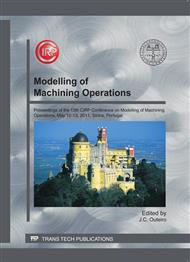[1]
K.L. Edwards: Designing of engineering components for optimal materials and manufacturing process utilisation, Materials & Design, Vol. 24 (2003), pp.355-366
DOI: 10.1016/s0261-3069(03)00041-4
Google Scholar
[2]
J. Ruan, K. Eiamsa-Ard, F.W. Liou: Automatic Process Planning and Toolpath Generation of a Multiaxis Hybrid Manufacturing System, Journal of Manufacturing Processes, Vol. 7 (2005), pp.57-68
DOI: 10.1016/s1526-6125(05)70082-7
Google Scholar
[3]
A. Larue, Y. Altintas: Simulation of flank milling processes, International Journal of Machine Tools and Manufacture, Vol. 45 (2005), pp.549-559
DOI: 10.1016/j.ijmachtools.2004.08.020
Google Scholar
[4]
L.N. Lopez De Lacalle, A. Lamikiz, J.A. Sanchez, M.A. Salgado: Toolpath selection based on the minimum deflection cutting forces in the programming of complex surfaces milling, International Journal of Machine Tools and Manufacture, Vol. 47 (2007), pp.388-400
DOI: 10.1016/j.ijmachtools.2006.03.010
Google Scholar
[5]
Z.D. Zhou, J.D. Zhou, Y.P. Chen, S.K. Ong, A.Y.C. Nee: Geometric Simulation of NC Machining Based on STL Models, CIRP Annals - Manufacturing Technology, Vol. 52 (2003), pp.129-134
DOI: 10.1016/s0007-8506(07)60548-4
Google Scholar
[6]
J. Zhang, S.K. Ong, A.Y.C. Nee: A multi-regional computation scheme in an AR-assisted in situ CNC simulation environment, Computer-Aided Design, Vol. 42 (2010), pp.1167-1177
DOI: 10.1016/j.cad.2010.06.007
Google Scholar
[7]
A. Abdul Kadir, X. Xu, E. Hämmerle: Virtual machine tools and virtual machining--A technological review, Robotics and Computer-Integrated Manufacturing, Vol. In Press, Corrected Proof (2010)
DOI: 10.1016/j.rcim.2010.10.003
Google Scholar
[8]
Machineworks: CNC Simulation and Verification, http://www.machineworks.com/, accessed 15 December 2010.
Google Scholar
[9]
Information on http://www.cgtech.com
Google Scholar
[10]
Information on http://www.ncsimul.com
Google Scholar
[11]
A. Dugas, J.-J. Lee, J.-Y. Hascoët: An enhanced machining simulator with tool deflection error analysis, Journal of Manufacturing Systems, Vol. 21 (2002), pp.451-463
DOI: 10.1016/s0278-6125(02)80051-6
Google Scholar
[12]
J.-Y. Hascoet, P. Dépincé, T.I. Seo: Compensation of tool deflection in ball-end millng simulation and experimental results, CIRP International Seminar on Improving Machine Tool Performance, conference proccedings, (1998), pp.375-388.
Google Scholar
[13]
D. Marinac: 2001, Tool path strategies for high speed milling, Modern Machine Shop Online, Information on http://www.mmsonline.com/articles/020004.html
Google Scholar
[14]
M. Rauch, J.Y. Hascoet: Rough pocket milling with trochoidal and plunging strategies, International Journal of Machining and Machinability of Materials, Vol. 2 (2007), pp.161-175
DOI: 10.1504/ijmmm.2007.013780
Google Scholar
[15]
S. Wakaoka, Y. Yamane, K. Sekiya, N. Narutaki: High-speed and high-accuracy plunge cutting for vertical walls, Journal of Materials Processing Technology, Vol. 127 (2002), pp.246-250
DOI: 10.1016/s0924-0136(02)00151-6
Google Scholar
[16]
S.D. Merdol, Y. Altintas: Virtual cutting and optimization of three-axis milling processes, International Journal of Machine Tools and Manufacture, Vol. 48 (2008), pp.1063-1071
DOI: 10.1016/j.ijmachtools.2008.03.004
Google Scholar
[17]
B. Anselmetti: Generation of functional tolerancing based on positioning features, Computer-Aided Design, Vol. 38 (2006), pp.902-919
DOI: 10.1016/j.cad.2006.05.005
Google Scholar
[18]
O. Legoff, S. Tichadou, J.Y. Hascoët: Manufacturing errors modelling: two three-dimensional approaches, Proceedings of the Institution of Mechanical Engineers, Part B: Journal of Engineering Manufacture, Vol. 218 (2004), pp.1869-1873
DOI: 10.1177/095440540421801219
Google Scholar
[19]
J. Lecompte, O. Legoff, J.-Y. Hascoet: Technological form defects identification using discrete cosine transform method, The International Journal of Advanced Manufacturing Technology, Vol. 51 (2010), pp.1033-1044
DOI: 10.1007/s00170-010-2687-2
Google Scholar


